Mohawk Mine, Silver Peak District, a site of progress and tragedy

Silver Peak District Background (1860s–1940s)
Silver Peak is one of the oldest mining areas in Nevada, first settled in 1864 after gold and silver discoveries in 1863. The district saw early milling activity (10- and 20-stamp mills by the 1860s) and intermittent production through the late 19th century. A major boom came in 1906 when the Pittsburg-Silver Peak Gold Mining Company consolidated local mines (including properties named Mohawk, Alpine, Silver Peak, Drinkwater, and Mary) and built a 100-stamp cyanide mill at Blair – at the time the largest in Nevada. This large-scale operation, supported by a branch railroad to Blair, made Silver Peak one of Nevada’s top producers of low-grade ore until it shut down in 1915 due to ore exhaustion. After a destructive town fire in 1948, Silver Peak’s activity waned until new developments in the mid-20th century – notably the Foote Mineral Company’s lithium brine operation in 1966 – breathed life back into the community. The Silver Peak district encompasses the Red Mountain area to the west (peaking at ~8,940 ft elevation) and adjacent outlying camps. The Argentite District was a name given in the 1920s to the southwestern part of Silver Peak’s territory (the Red Mountain area), though this name did not persist long-term. Mohawk Mine is located in this southwestern sector (Argentite/Red Mountain area), about 10 miles west of the town of Silver Peak. The Mohawk would emerge as one of the district’s significant mid-20th century silver mines, helping sustain Silver Peak during an otherwise quiet period.
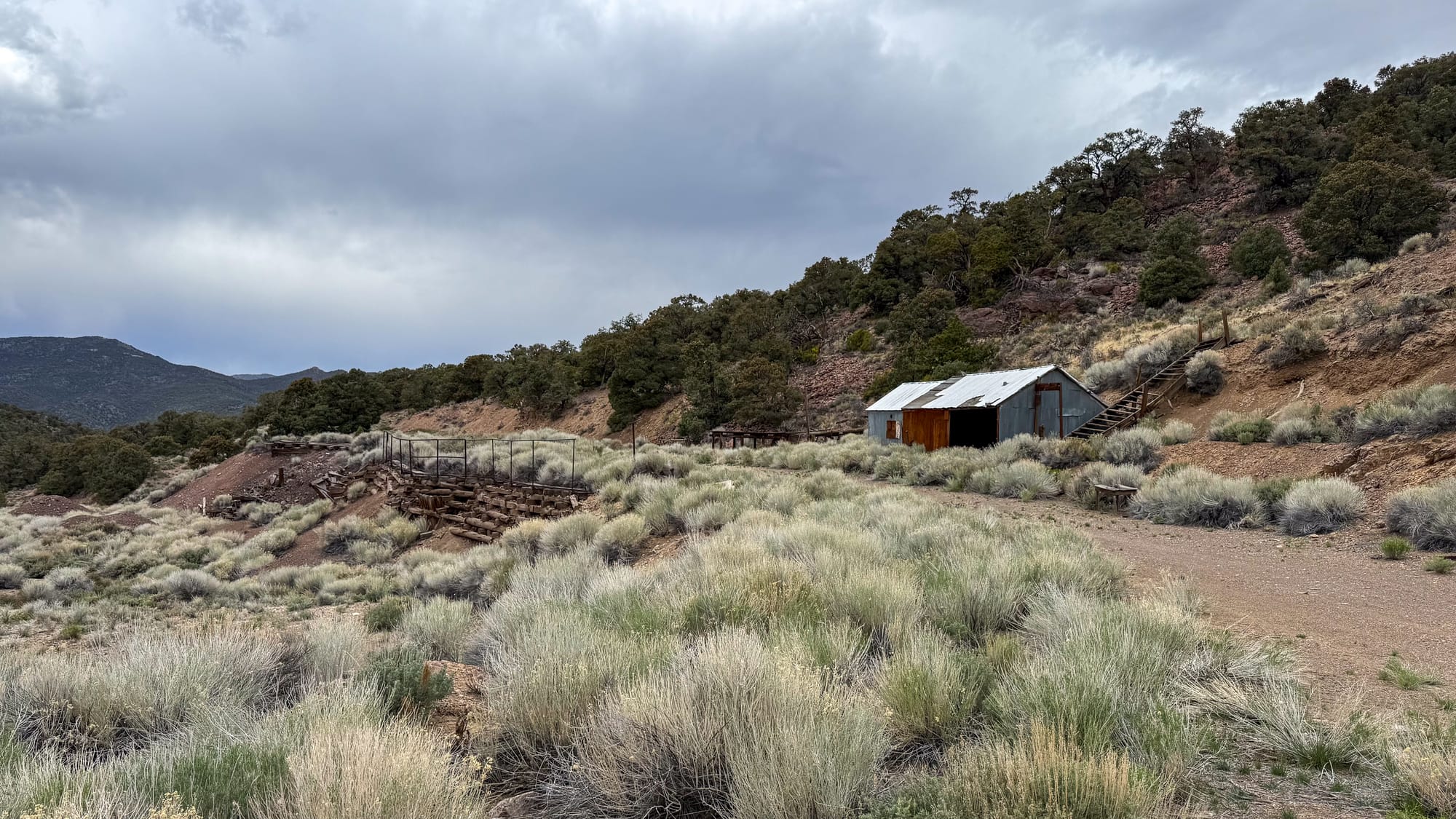
Discovery and Early Development (1910s–1920s)
The lode that became the Mohawk Mine was originally known as the “Argentite” vein and was discovered prior to 1920 by Ernest “Ernie” Shirley (reportedly when he was a teenager). Shirley and his partners (including his brother Louis, Stanley Chiatovich, and Harvey Humphrey) staked claims on this high-elevation silver deposit around 1920. In 1921, a Canadian company undertook the first significant development by sinking an inclined shaft along the vein down to the 500-foot level. This incline shaft established the primary access to the orebody and would later connect to multiple levels of workings. Early assay results were very encouraging – a set of 1921 samples included extremely high silver values (ranging up to 365 oz/ton Ag) – but the mine’s remote location posed serious challenges. The nearest water source was roughly 10 miles away, and the ore had to be hauled ~24–25 miles by road to reach a mill or railroad. These logistical difficulties meant that only high-grade ore could be economically shipped; reportedly, the Mohawk operation “took no ore to the mill under 15 ounces per ton” silver content, whereas mines nearer to infrastructure could work lower grades.
Throughout the early 1920s, prospecting and limited production continued at Mohawk (often in conjunction with the neighboring Sanger/Francis Mine in the Argentite camp). The Esmeralda County commissioners funded a wagon road into the Argentite camp in 1921 to improve access. Even so, recorded production from the Mohawk during this period was minimal – no substantial ore shipments are documented in the 1920s. By 1922, a few tons of rich silver ore were likely shipped directly to smelters (via rail at Coaldale) from the camp, but low silver prices soon curtailed operations. For the next few decades, the Mohawk property saw only intermittent work. The focus in the 1930s was largely on the Sanger (Francis) mine, which had British investors and development efforts, while the Mohawk vein lay mostly dormant awaiting more favorable economics. A 1947 report noted the Argentite area had seen considerable underground development (multiple shafts retimbered and ore showings exposed) but remained idle in winter due to deep snow at the 8,300 ft elevation. In short, the Mohawk’s rich silver vein was known, but it would not be fully exploited until the silver market and capital investment aligned in the 1950s.

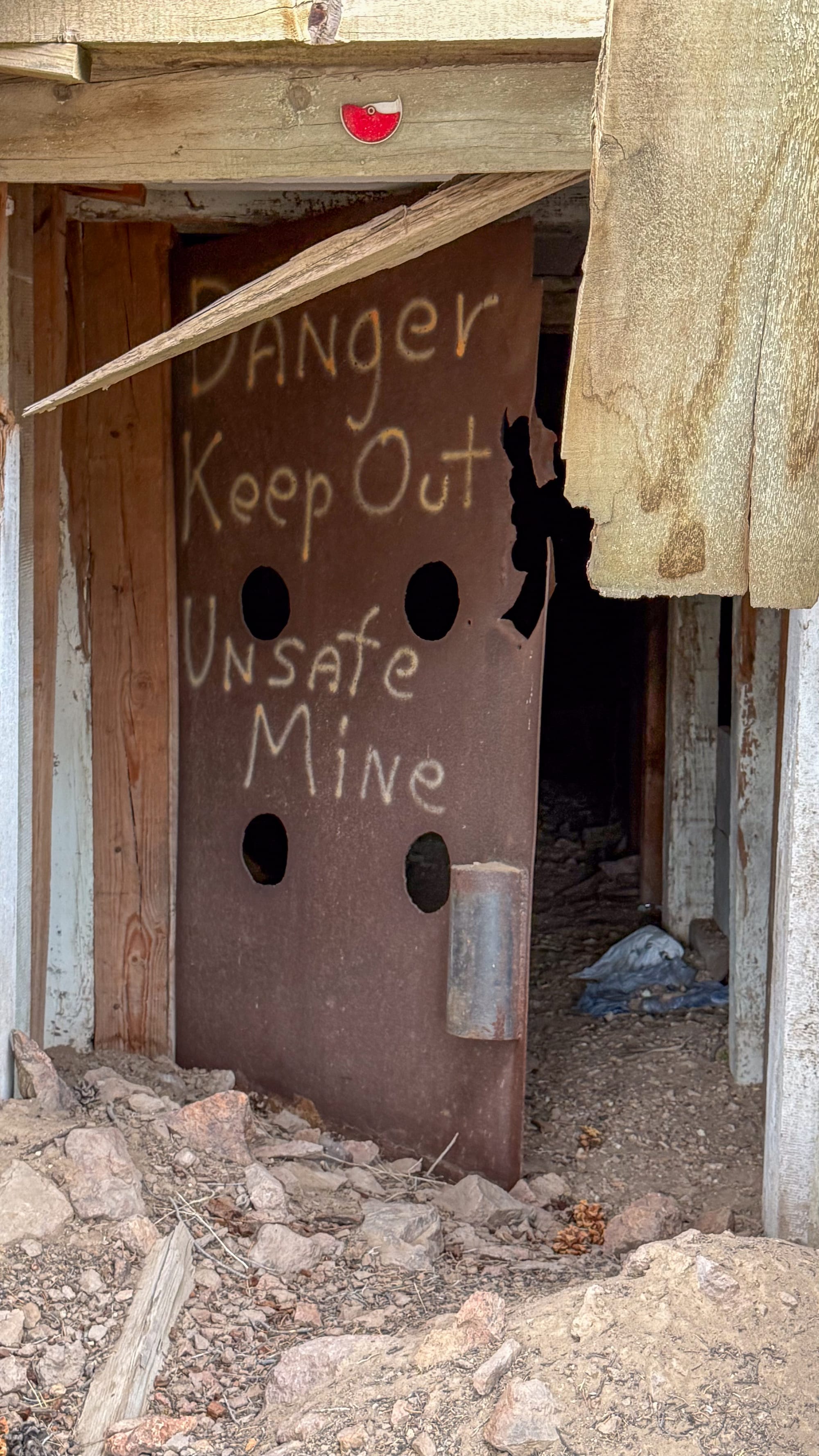
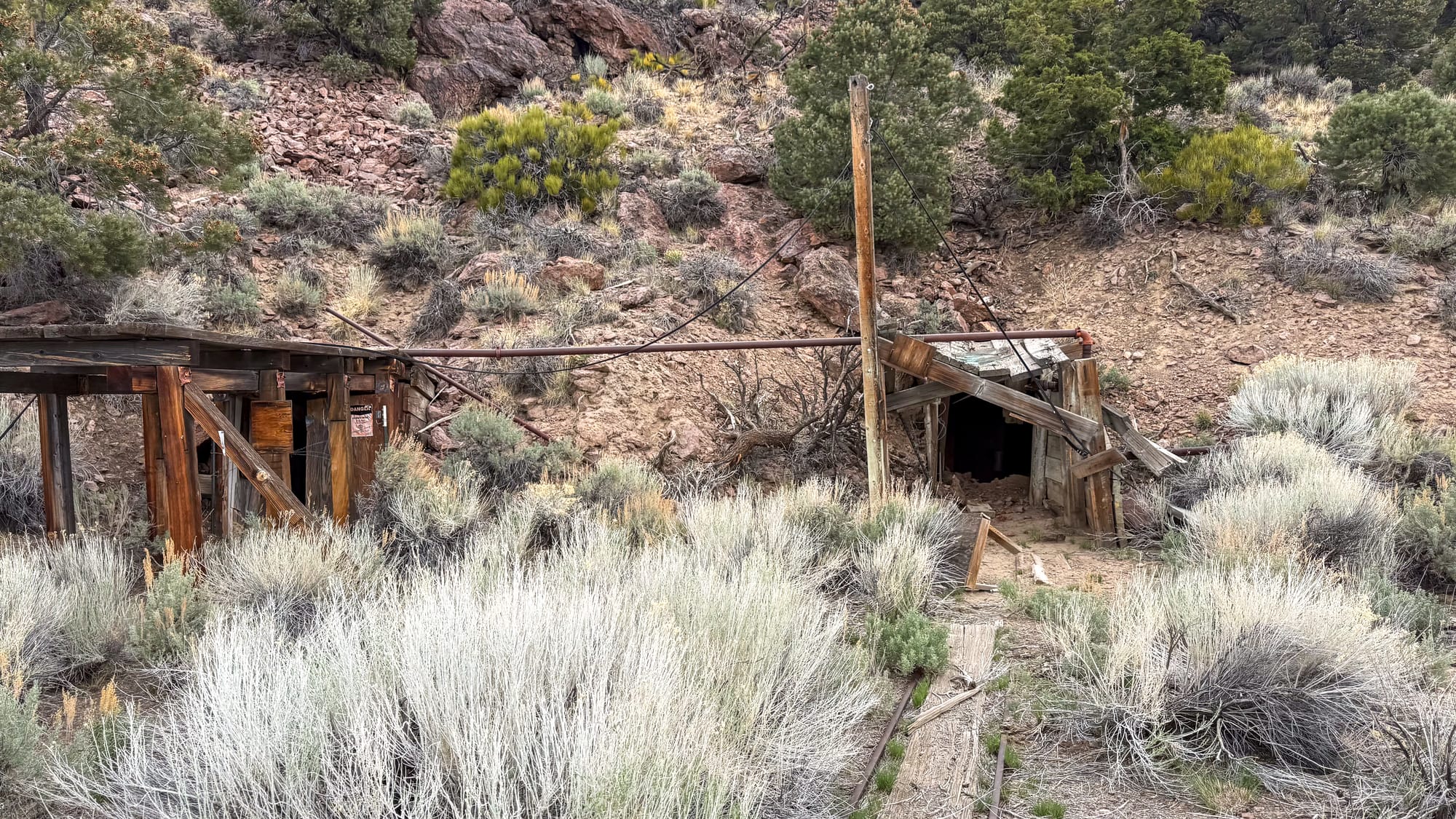
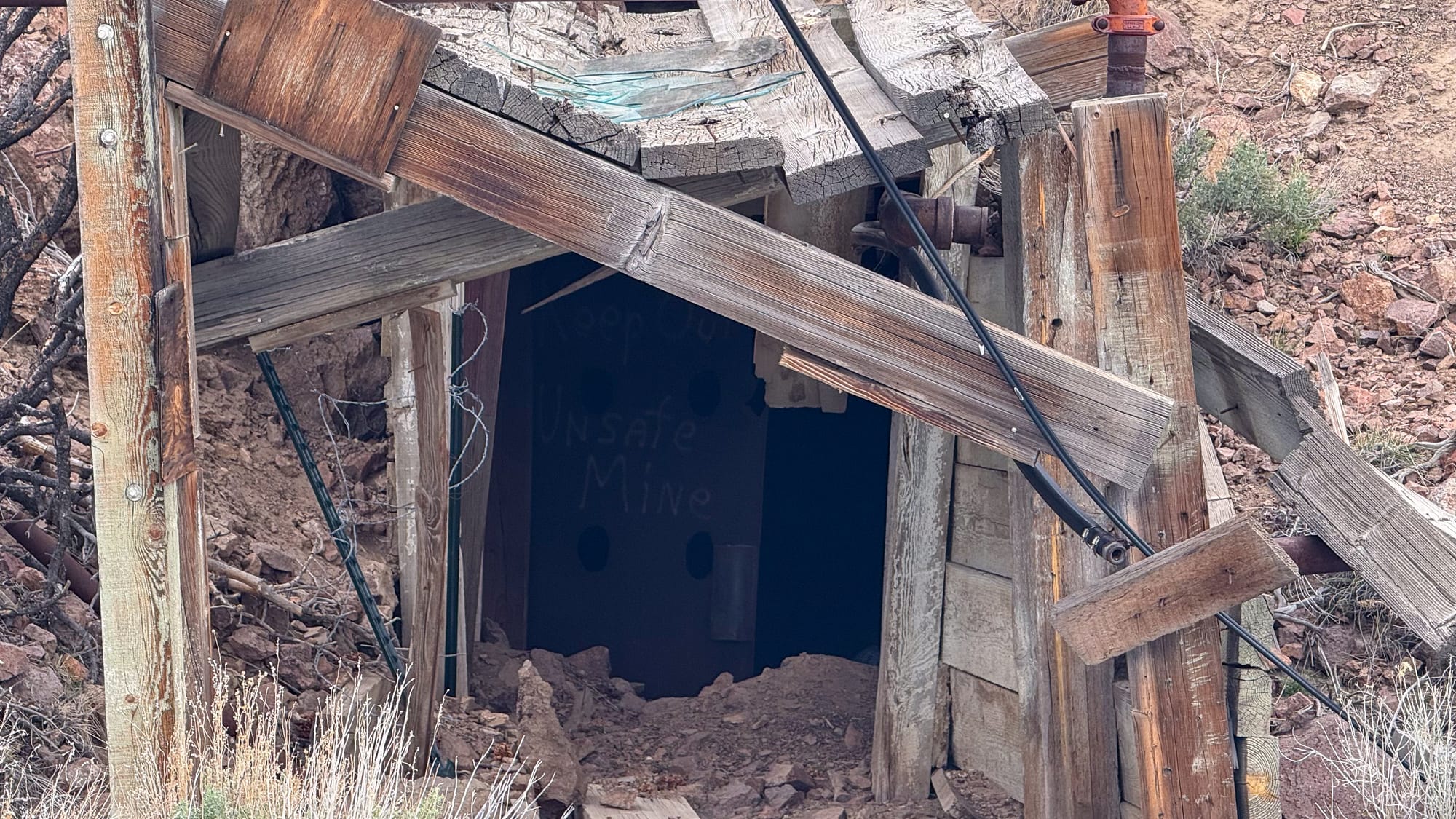
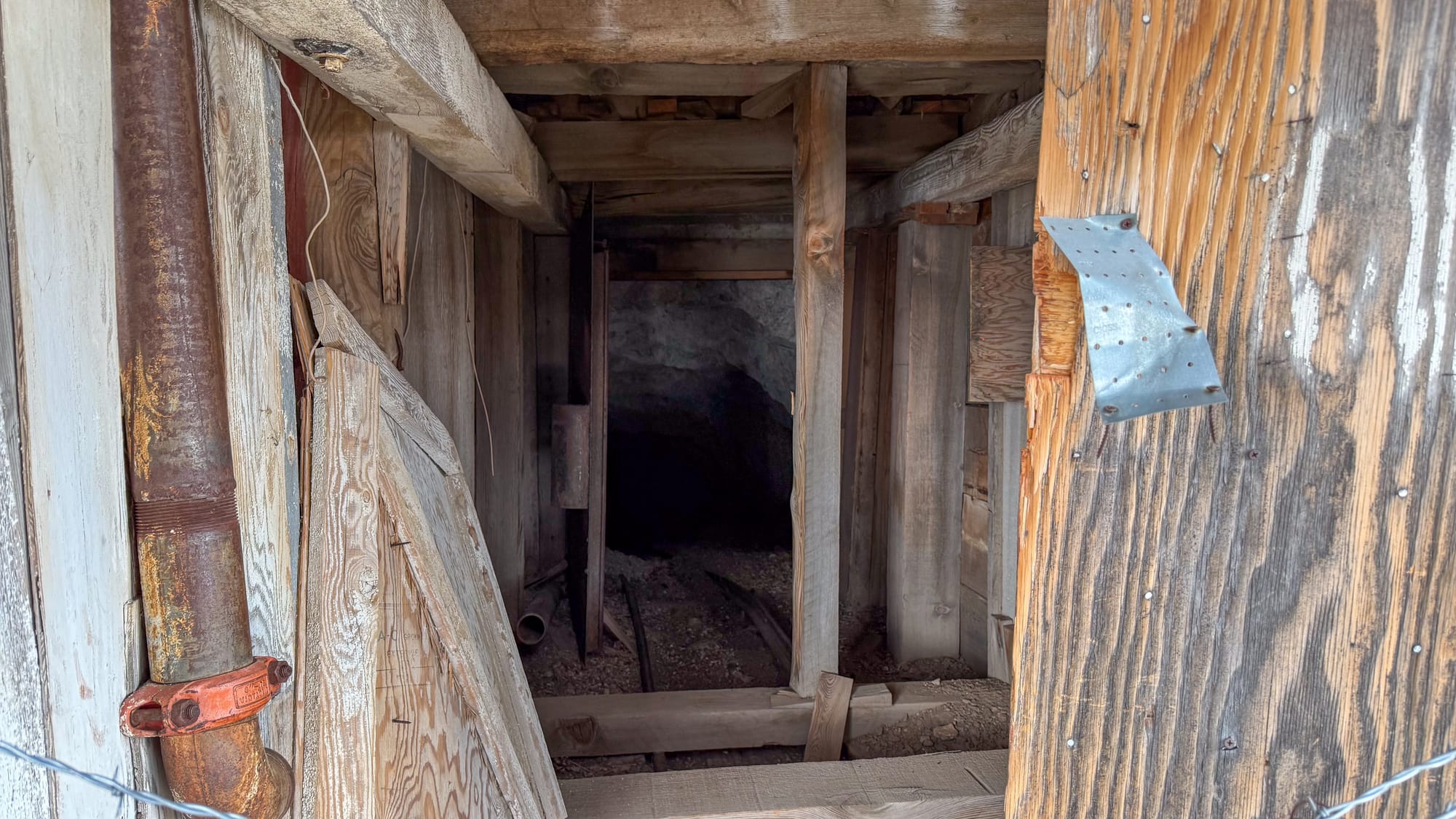

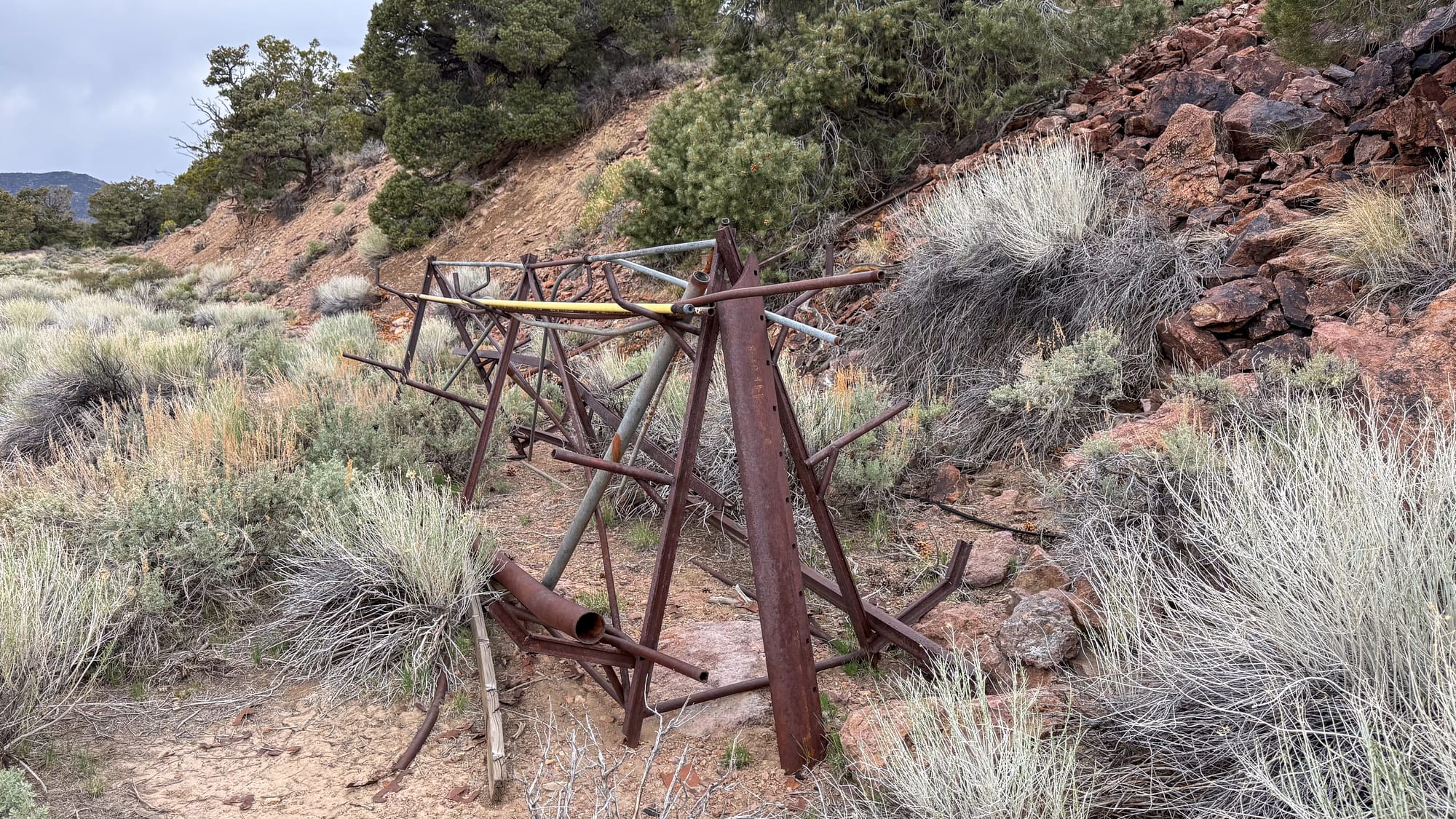
The lower workings of the Mohawk.
Mid-Century Revival and Major Development (1950s)
The Mohawk Mine’s true boom came in the early 1950s, when high silver prices and new investors sparked a revival. In 1951, Ernie Shirley optioned the property to E. R. Hines, a mining promoter who in turn brought in Avery Brundage, a wealthy Chicago businessman (better known as an Olympic Committee chairman). Exciting high-grade discoveries were made during this time – one 1951 news report described a “remarkable strike” with miners drifting over 200 feet in continuous ore averaging over $40 per ton (≈40–50 oz/ton Ag), with “no walls in sight” in the vein. Rumors even swirled that a major company had offered $1.5 million for the Mohawk, underscoring the excitement around the find.
To develop the mine at full scale, Avery Brundage formed Bruhi (Brundage-Hines) Enterprises in 1953 and oversaw a major expansion program. That year, Bruhi optioned the Mohawk to the Sunshine Mining Company of Idaho (a prominent silver producer), but Sunshine withdrew within a year after some evaluation drilling. Brundage then decided to proceed on his own. In 1954, work began to modernize the mine and to construct a processing mill at Silver Peak, since no nearby mill was available. By 1955 the new mill was completed in Silver Peak town, and it treated Mohawk ore continuously until 1956. This mill was likely a cyanide leaching plant or flotation mill designed for silver ore, with an initial capacity around 100 tons per day.
Underground, the mine was developed with a vertical shaft (in addition to the old incline) and multiple levels of drifts and stopes. By the late 1950s, Mohawk had one main shaft, one incline shaft, six levels, and about 1 mile of underground workings, including several large stoping areas (with names like the Hines, Luft, Burgess, Elree, and Brundage stopes). Surface infrastructure at the high-altitude camp grew to include a power plant (generators), hoist house, workshops, and living quarters for the workforce. Electricity, mechanized drills, and mine carts/locomotives were used to extract and transport ore, reflecting mid-century mining technology. During 1955–1956, dozens of miners were employed and Mohawk became a major silver producer for the region.
However, by mid-1956 the operation hit a downturn. The mine and mill were abruptly shut down in 1956, reportedly due to a combination of factors: a mill equipment failure and a dispute over ore grade, as well as fluctuating silver prices. Brundage then sold the new mill to the U.S. Mining and Milling Corporation (USM&M) of New York in late 1956. USM&M repurposed this Silver Peak mill to process ore from other regional mines – for example, by 1958 the mill was treating about 75 tons/day of ore trucked in from the Ohio mine near Goldfield. The Mohawk Mine itself saw limited activity in 1957–58, essentially on care-and-maintenance. Still, the mid-1950s run had been fruitful: roughly 40,000 tons of ore were produced from the Mohawk between 1954 and 1961, at an average grade of about 25 oz/ton silver. This equates to around 1,000,000 ounces of silver recovered in the Brundage era. The Mohawk’s rich vein and new infrastructure positioned it for continued production under new ownership as the decade progressed.
The 1959 Collapse – Tragedy Underground
In 1959, operations at Mohawk were resumed under U.S. Mining & Milling Co., but a disaster struck that would become a defining moment in the mine’s history. On October 16, 1959, a massive cave-in occurred in the Hines 202 stope (named after E. R. Hines, one of the principals) at the 300 level of the mine where three miners, on the overnight shift, were removing equipment from the condemned stope. Hundreds of tons of rock collapsed without warning, trapping the three miners. Despite immediate and heroic rescue attempts – specialists and equipment were brought from across the country – the three men could not be reached. After eleven days of continuous but fruitless digging, the Nevada State Mining Inspector, Mervin Gallagher, called off the rescue on October 27 and ordered the mine sealed for safety. Tragically, the Mohawk Mine became the final resting place of the three miners: William "Bill" Delorme, James “Jimmy” Roberson, and Samuel "Sam" Sickles. Contemporary newspapers provided detailed coverage of the accident and the coroner’s inquest (see Tonopah Times-Bonanza, Nov. 6, 1959). The investigation revealed that an extensive open stope had been mined out, reportedly up to 80 feet in height, and its unsupported span likely contributed to the catastrophic rockfall. The incident underscored the dangers of aggressive underground mining in the fractured, brecciated rhyolite host rock.
Following the disaster, Mohawk operations were suspended, and that section of the mine was abandoned. For a time the shaft and workings remained closed as a tomb. However, the mine was not entirely given up on – after sealing the caved area, USM&M resumed mining in other parts of Mohawk by early 1960. Limited production and development continued into 1961, but the mine closed again by June 1961, ending the first full-scale era of Mohawk. The 1959 cave-in remains one of Nevada’s notable mining tragedies, and to this day the victims’ bodies are entombed in the collapsed stope deep inside the mountain.
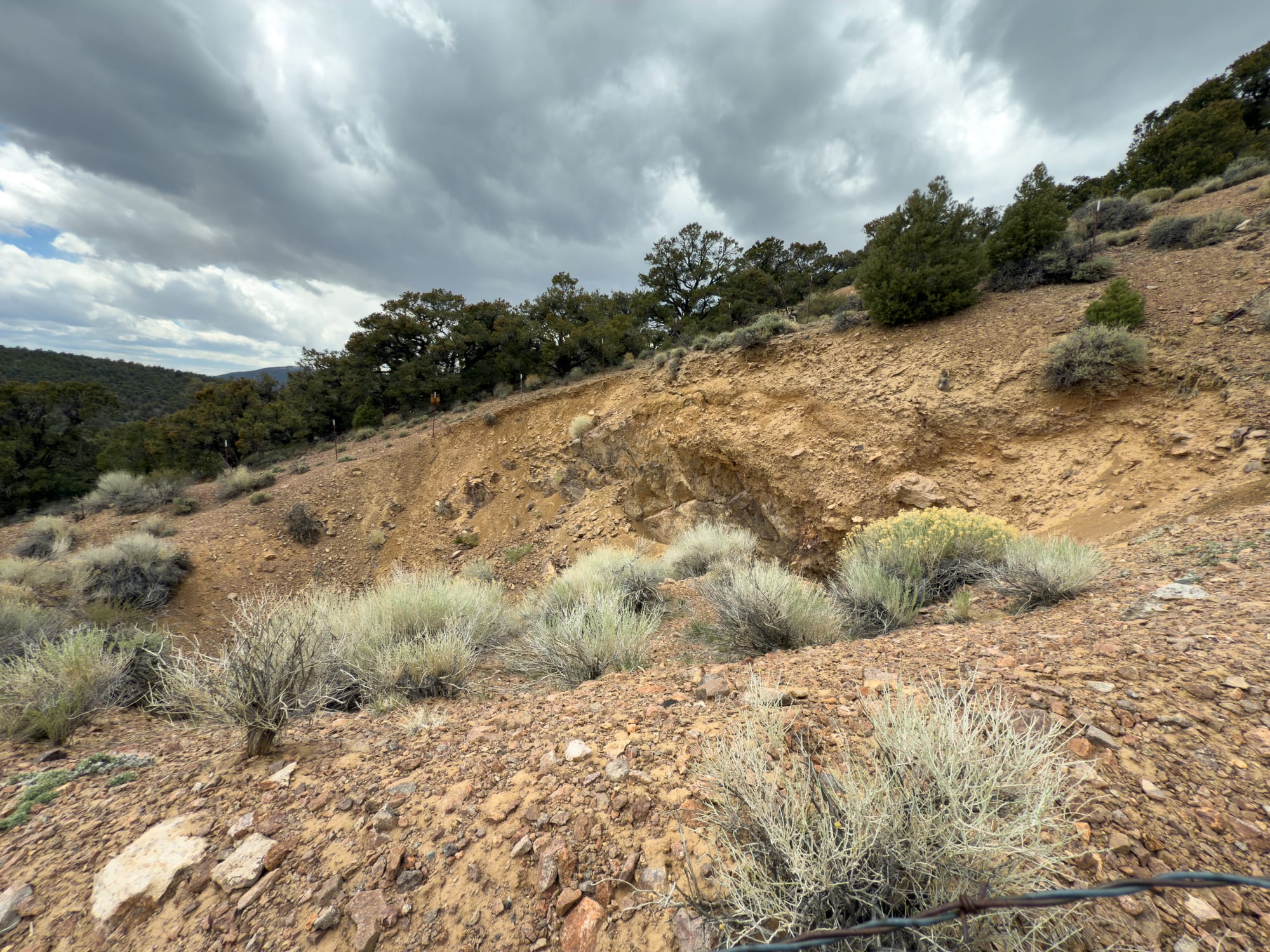

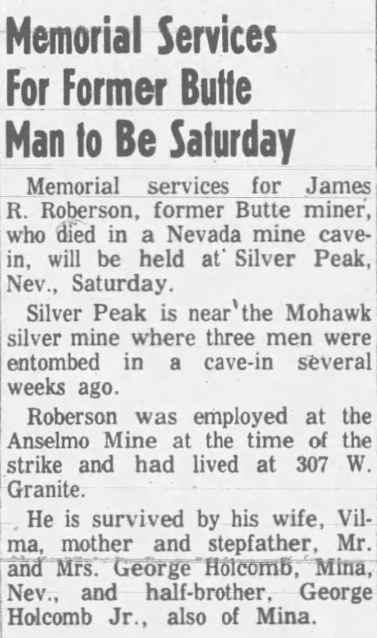
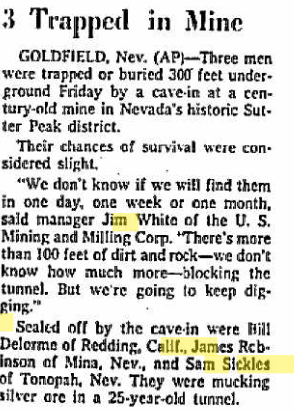
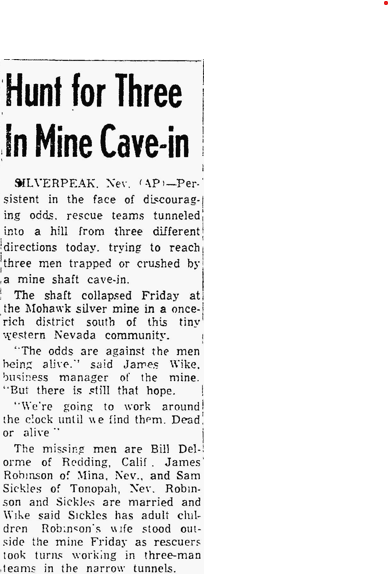

Newspaper coverage of the collapse.
Exploration and Revival Attempts (1960s–1970s)
After 1961, the Mohawk Mine lay mostly idle, but it was far from forgotten. In the 1960s, rising silver prices and improved technology spurred new exploration. Sunshine Mining Company (the Idaho silver firm) returned to Mohawk and, along with Mid-Continent Uranium Corp., conducted extensive diamond drilling programs in the mid-1960s. Their aim was to test the downward extensions of the known ore shoots below the 500-ft level and to explore along strike of the vein system. A 1964 stockholders’ report envisioned a major expansion: geological studies indicated significant ore reserves above the 500 level (estimated ~37,000 tons at ~21 oz/ton Ag) and projected that substantial additional ore (127,000+ tons at ~20 oz/ton Ag) might exist at depth if the veins continued downward. To access these deep extensions, engineers proposed driving a 7,500-foot crosscut tunnel through the mountain from a lower elevation, which would intersect the Mohawk vein system at depth and potentially connect to the neighboring Sixteen-to-One mine workings. This ambitious plan, however, was contingent on drilling success. By the late 1960s, Sunshine and Mid-Continent had indeed identified some deeper mineralization, but the full tunnel project was never realized – likely due to funding issues and the volatile silver market. Mid-Continent did improve the site’s infrastructure and kept the property in good standing; for instance, they upgraded roads and maintained the camp, anticipating a future restart.
The next significant revival came in the 1970s, amid a sharp rise in silver prices. Around 1974–1975, a small operator known as Spring Creek Mines (headed by Jack Zane and Mark Gavard, local mining promoters) leased the Mohawk and brought it back into production on a modest scale. Uniquely, Mohawk at this time retained the flavor of an old-time mining camp. The operation was so remote that miners lived on-site in company housing rather than commuting. Three large wooden bunkhouses (one for each shift: day, swing, and graveyard) were refurbished at the camp, along with a “humongous” cook shack where a hired camp cook prepared ample meals daily. As miner Ben Viljoen recalled, the Mohawk in 1975 was “about the last of the old-type mines” with a traditional bunkhouse-camp setup – a way of life that was fast disappearing in American mining by the 1970s. The underground workings were rehabilitated, and mining resumed on some of the ore left behind from earlier years. Spring Creek Mines reportedly shipped small batches of high-grade ore for custom processing (since the Silver Peak mill was no longer available) and may have conducted trial runs. This revival was relatively brief; by the late 1970s the operation slowed, possibly awaiting further investment. Nonetheless, the mid-’70s episode demonstrated that substantial silver remained in the Mohawk vein, and it kept the mine in the local headlines once again.
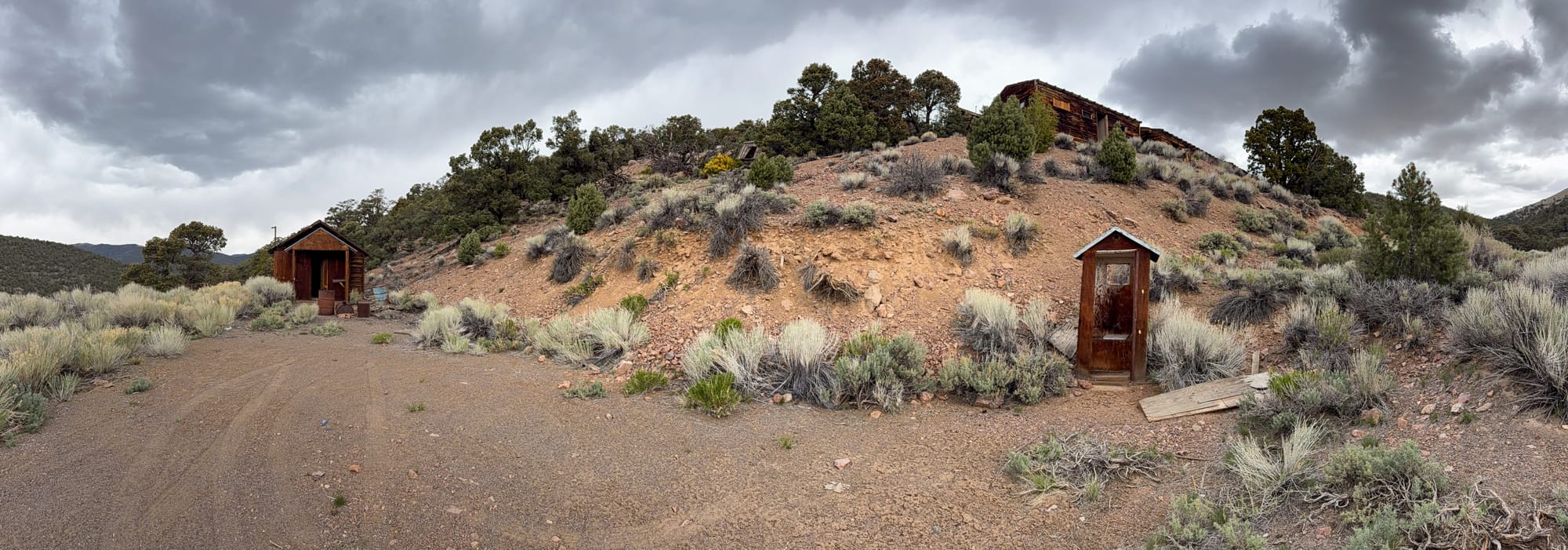
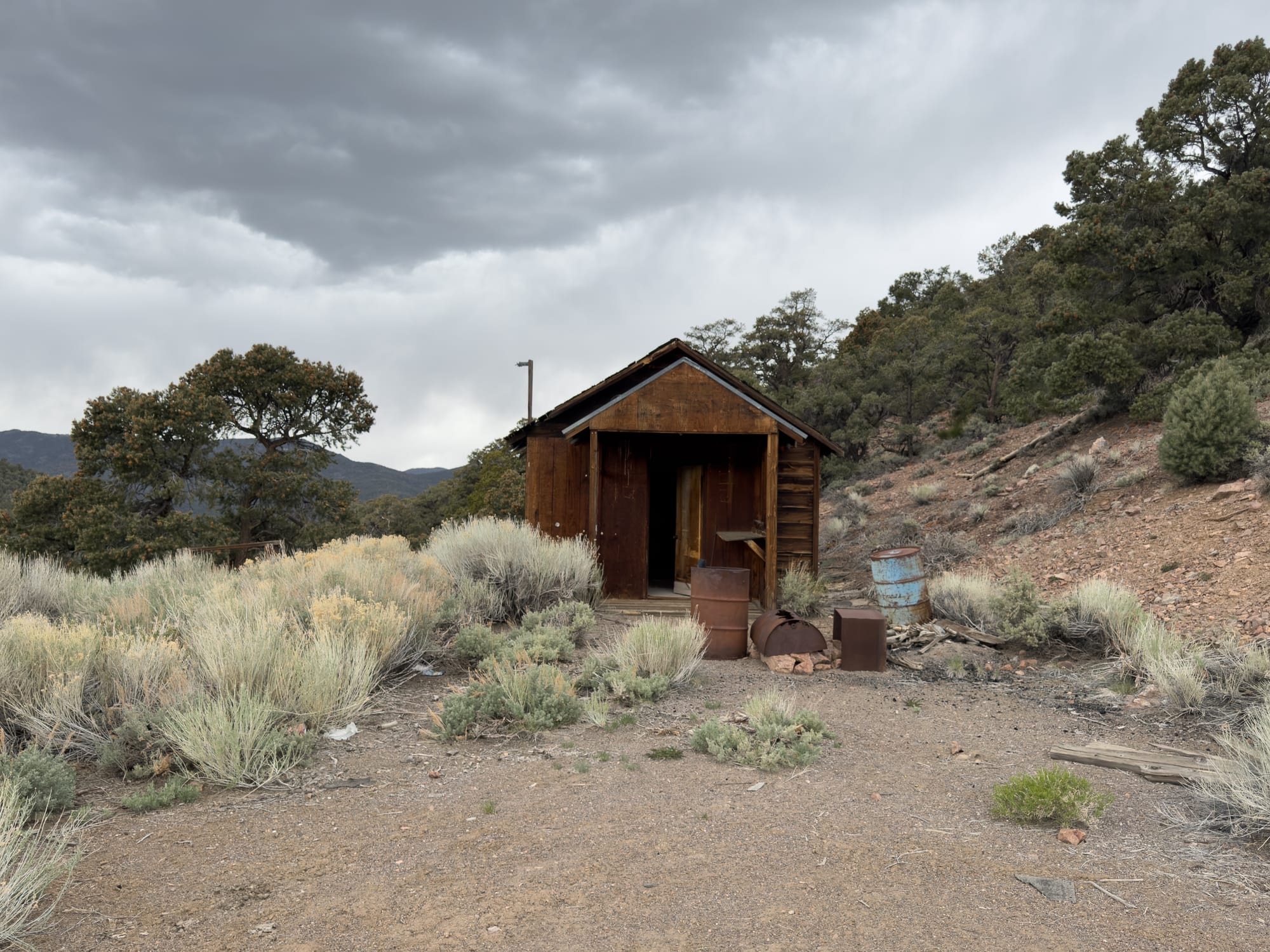
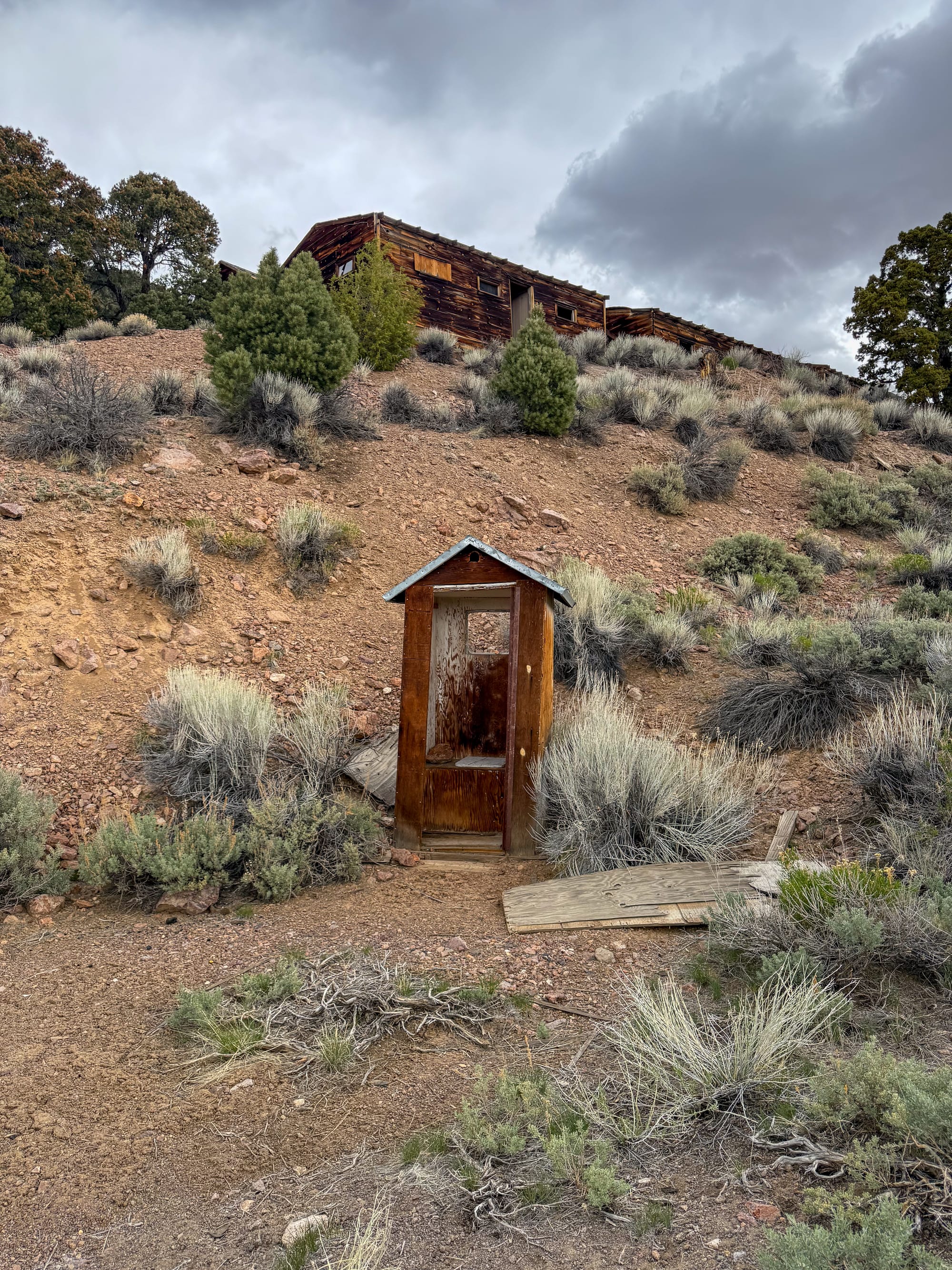
The superintendents house and outhouse, lower level.
Final Years and Current Status (1980s–Present)
The last significant chapter in the Mohawk Mine’s history unfolded around 1980–1981, coinciding with record-high silver prices. Mohawk Mines Inc. (the then owner of the property) attracted a new partner – Veta Grande Companies, Inc. – which announced plans in late 1980 to purchase the mine and greatly expand operations. At that time, the Mohawk was reportedly capable of 100 tons per day of output, and Veta Grande proposed to increase capacity to 300 TPD within 18 months. Modernization and scaling up would have likely involved new underground development and a larger mill or enhanced ore transport. Indeed, in 1980–1981 the mine was listed as an active underground silver mine employing 29 workers. Because no mill existed on-site, ore was hauled out for processing – historical accounts note that Mohawk ore was trucked to the Veta Grande Company’s mill near Minden, NV for treatment during this period. By May 1981, local newspapers like the Tonopah Times-Bonanza reported that Mohawk had resumed regular shipments of silver ore.


The modern workings at the Mohawk.
This early-’80s revival was short-lived. The global silver market collapsed from its 1980 peak (the Hunt Brothers’ silver boom), eroding the economic feasibility of Mohawk’s expansion. It appears that by 1982, full-scale mining at Mohawk ceased once again. Veta Grande’s ambitious plans were never fully realized, and the property entered a long dormancy. As of the mid-1980s, observers noted that the Mohawk Mine site was maintained on standby – with all surface facilities intact and guarded, “ready for full operation with no delay” as of 1984 – but no active production was occurring. In subsequent decades, the claims have changed hands among exploration companies, yet no large mining campaign has restarted. The rich Mohawk vein system remains in the ground, offering potential should silver prices rise sufficiently, but the challenges of access and capital have so far kept it idle.

These derelict structures housed miners in the mid-20th century and again during the 1970s revival, when Mohawk was one of the last U.S. mines to maintain an old-style on-site bunkhouse and cookhouse for its crew. Today the Mohawk site is abandoned – a high-elevation ghost camp accessible only by rough 4×4 trails. The mine openings have been sealed or collapsed (partly due to the 1959 cave-in), effectively making the mountain a grave for the three miners lost in that tragedy. Visitors to the site can still see the skeletal remains of camp buildings, scattered mining equipment, and the scars of the surface works. Geologically, the Mohawk deposit remains significant: it is a steeply dipping epithermal fissure vein system hosted in Tertiary rhyolite of the Silver Peak caldera, characterized by quartz veining with argentiferous galena and associated gangue minerals (calcite, barite, manganosiderite). The veins, often narrow at the surface, widen with depth and carry high-grade silver (with minor gold and base metals) in the form of sulfides and sulfosalts. Over its intermittent lifespan, the Mohawk Mine produced on the order of 1–2 million ounces of silver in total and left behind additional defined resources – a testament to the richness of the Silver Peak range’s geology. Whether the Mohawk will ever roar back to life remains uncertain, but its legacy is firmly etched in Nevada’s mining history: a boom-and-bust silver mine that bolstered a community, witnessed both great promise and great tragedy, and today stands as an artifact of a bygone mining era.

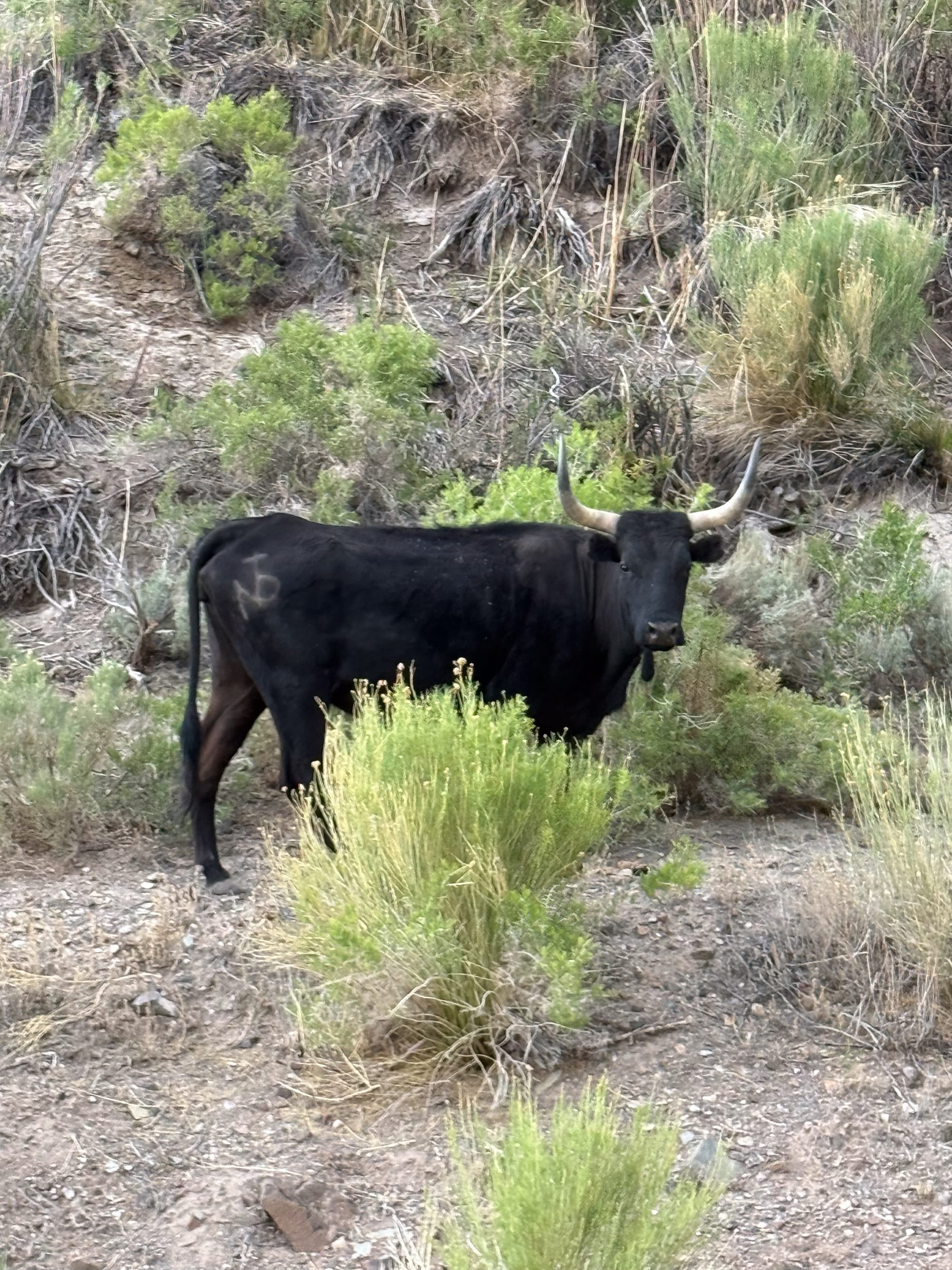
Sources
- Ford, V. (2002). Silver Peak: Never a Ghost Town. University of Nevada Oral History Program – (Includes historical narrative and oral interviews on Silver Peak and Mohawk Mine).
- Shamberger, H. A. (1976). The Story of Silver Peak, Esmeralda County, Nevada (Historic Mining Camps of Nevada Series No. 8) – Nevada Historical Press.
- U.S. Geological Survey (1977). Geology of the Red Mountain Mining District, Esmeralda Co., NV (Bulletin 1423 by W. J. Keith) – Geologic context of Mohawk (Argentite) veins.
- Nevada Bureau of Mines & Geology archives: Esmeralda County mining district files (Incl. Mid-Continent Uranium Co. 1964 stockholder report on Mohawk); NBMG Bulletin 78 (1972) on Esmeralda County mineral deposits.
- Western Mining History – “Mohawk Mine” (summary of mine data and timeline); “Silver Peak, Nevada” (town history).
- Forgotten Nevada (Ghost Towns) – “Argentite” page (compilation of historical newspaper excerpts and reports on the Argentite/Mohawk area).
- BackcountryExploring.com – “Mohawk Mine” (site visit report with timeline of events and photos of the Mohawk camp).
- Contemporary newspaper articles: Nevada State Journal (Dec 12, 1951) on Mohawk strike; Tonopah Times-Bonanza (Nov 6, 1959) on the cave-in inquest; Nevada State Journal and Goldfield News (1980–81) on the Mohawk’s final reopening.
